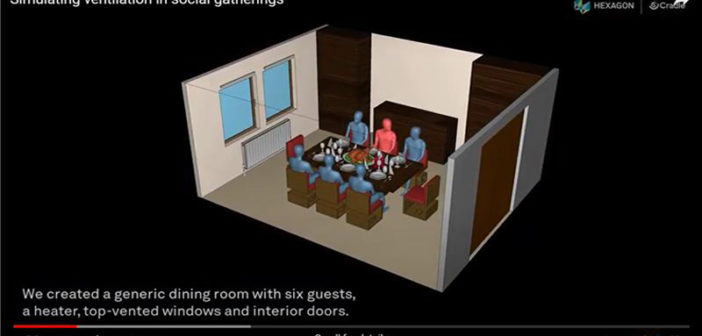As families and friends look forward to a restful end of year, many of us are considering the risk to ourselves and to our loved ones of gathering to celebrate.
Governments are continuously updating their advice based on statistical models and science, issuing new rules and guidance to help us all play an important role in controlling the virus.
For non-experts, it can be very useful to visualise how wearing a mask and social distancing can help each of us stay safe and protect others. So, at Hexagon, we have been putting the power of our physics-based simulation tools to work in recent months to help authorities and individuals see and understand the risks of airborne contagion.
Simulation
Physics-based simulation shows us how something behaves, breaks, sounds or flies without having to spend time and money constructing multiple scenarios in the real world.
Previously the ability to create a virtual wind tunnel, for example, was the preserve of big companies such as Boeing or Airbus, or Formula 1 teams, as only they had the stringent performance and regulatory requirements that warranted heavy investment in the knowledge and hardware needed to run large software simulations. Ongoing advances in computing technology, however, have made physics-based simulation widely accessible.
Now, almost anyone can use simulation software to understand how and why things happen and predict how different factors will shape outcomes. For this reason, manufacturers use it to design better smartphones, faster cars or more sustainable aircraft.
When it comes to modelling droplets in the air, we use the simulation discipline called Computational Fluid Dynamics (CFD). While it remains one of the more complex fields in physics-based simulation, tools such as Hexagon’s Cradle CFD make it easier to use, supported by the availability of cloud computing to crunch the numbers.
Six is a crowd
As the festive season approached, we simulated what is happening unseen in the air of a warm, cosy room full of people chatting, laughing and sharing food. The UK scientific advisory group, SAGE recommends rooms are ventilated for 10-20 minutes every hour to dilute the concentration of infectious COVD-19 droplets. We therefore set out to simulate the impact of ventilation on the spread of airborne droplets within a realistic small social gathering using CFD, which a BBC science correspondent used to great effect in a recent broadcast report.
In the video we created you can see how ventilation can have an impact on our safety in numbers. You can also find further visualisations on our website.














